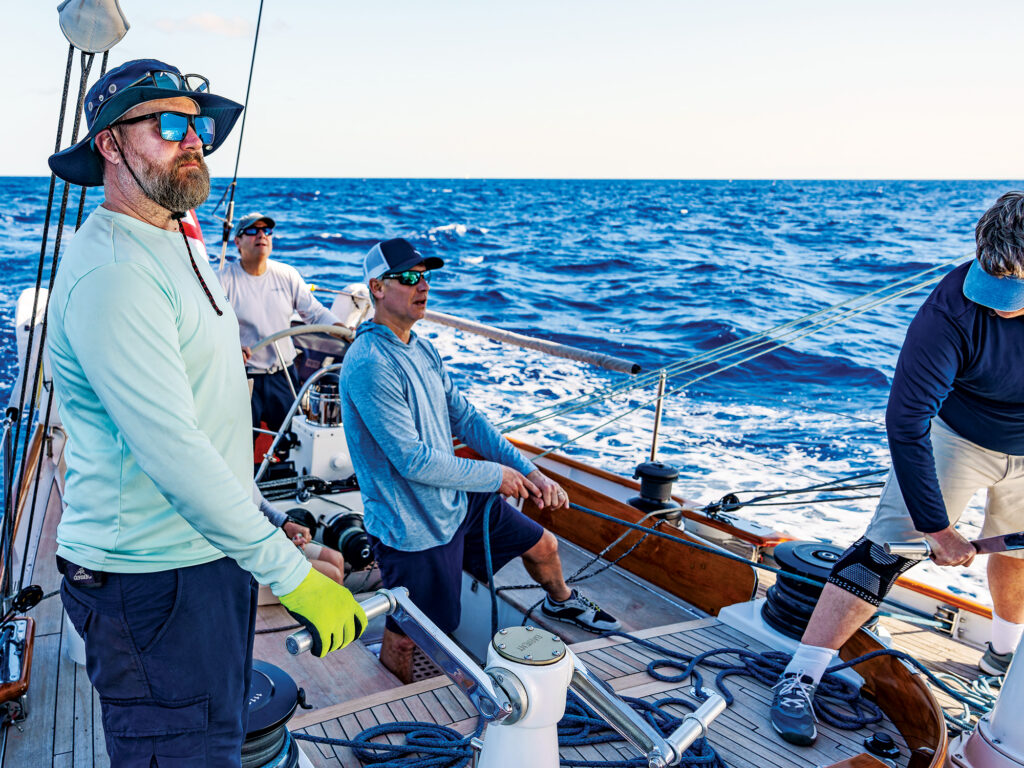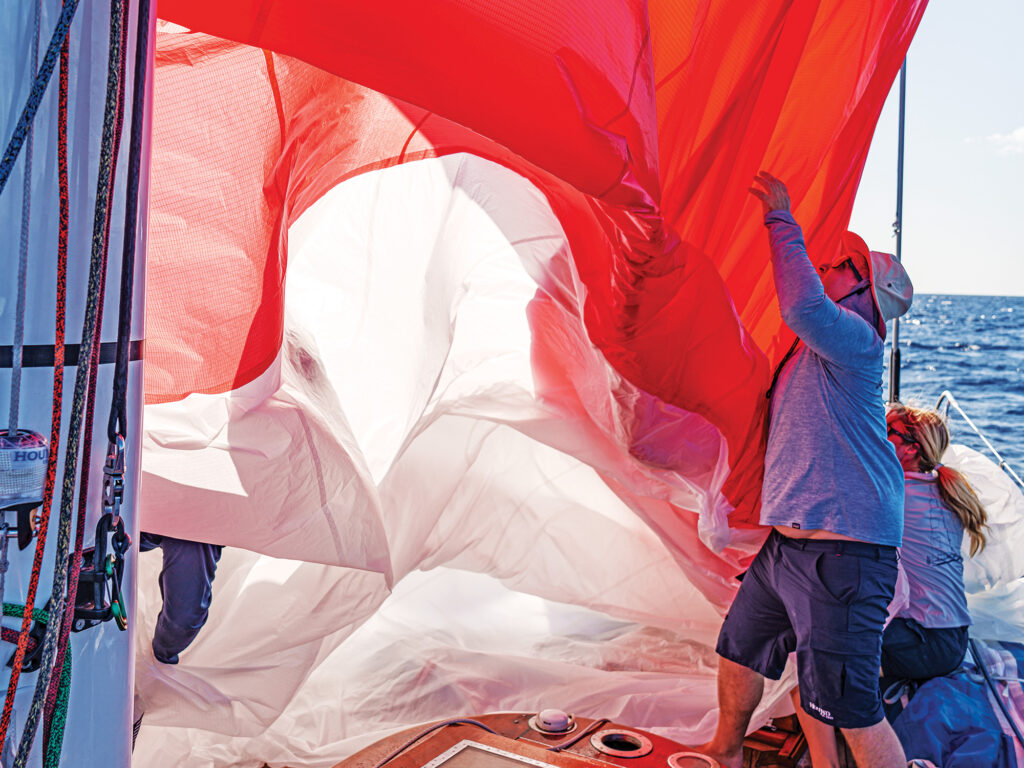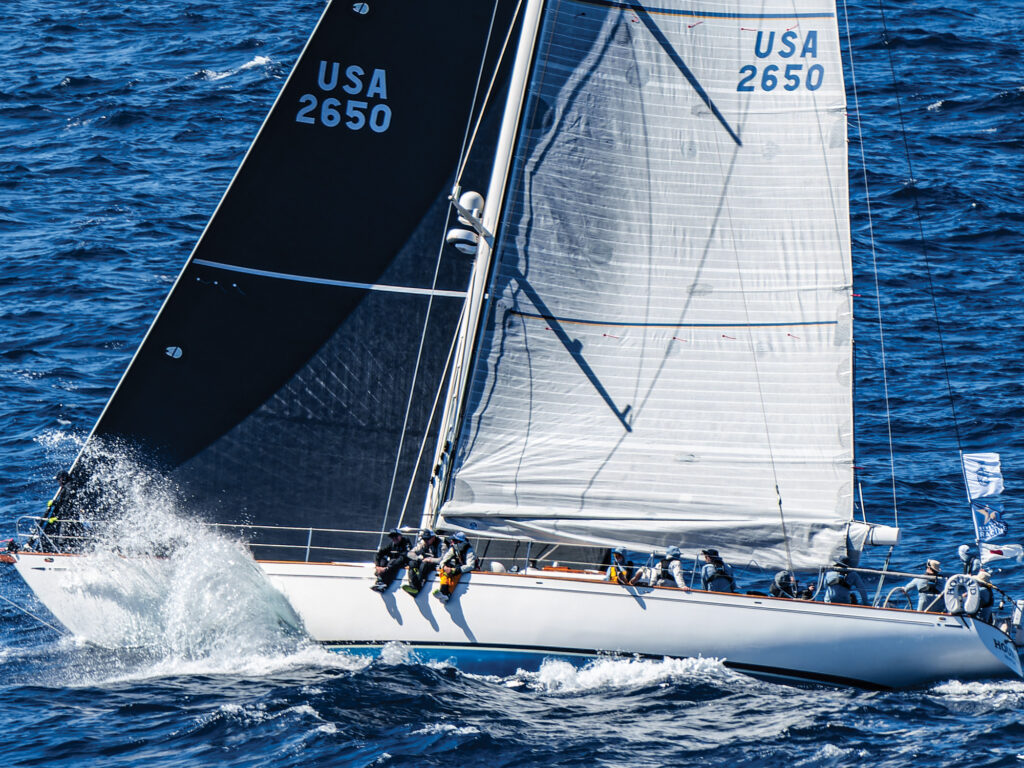World
Running Tide Runs Swiftly Still | Sailing World

Paul Cronin
When I walk out onto the bustling Catamaran Club dock a few hours before the start of the Royal Ocean Racing Club’s Caribbean 600, I’m surrounded by the broad-hipped carbon transoms and graphics of the world’s shiniest race boats. Wide decks swarm with sailors rigging up for a unique 600-mile romp around a dozen island “marks,” so I dutifully admire their prods, wraparound bows, and swept-back spreaders. But my gaze quickly strays to a far different profile: the slim waist, long overhangs, and immaculate varnish of Hound, tugging at its dock lines in the building trade winds, anxious to bound into open water.
Casual boat-gawkers might assume that this 1970 Aage Nielsen design is just a poster child for a bygone era of yacht design, with race glory a distant memory. But there are 15 crew swarming its teak decks: loading sails, rigging sheets, removing the large boom tent. And the competition recognizes most of them because this is the same core team who won not just the classics trophy in 2023, but also IRC One.
“Hound is a great all-around boat,” Taylor North explains, when I drag him away from prerace chores to ask why a sought-after bowman would choose to sail on a boat old enough to be his mother. Instead of rolling his eyes about the generational gap, he quickly ticks off Hound’s assets. “She looks good at the dock. And she sails really well. Some modern boats, you get into certain conditions where the boat just feels sticky. Last year, we held off boats that were much quicker than us on paper. We’re not going as fast, but we are going pretty well all the time; there aren’t very many times where we’re saying, ‘This is not our conditions.’”
He then glances out at the glorious trade winds, which are forecast to die away to nothing and then veer all the way around to the north. “Obviously, if it turns into light-wind running…maybe on Friday, I might have a different opinion.”
Hound (née Pleione) was commissioned by Arthur Santry Jr. and launched by Abeking & Rasmussen in spring 1970. Santry raced it to Bermuda, introduced the family to cruising, and gained a new sail plan and underbody before Frank and Delphine Eberhart took ownership in 1984. The new owners cruised extensively, including a historic 1991 passage to Leningrad with four kids under 9, just as the Soviet Union was collapsing. In 1998 and 2002, Hound posted its first two Bermuda Race class wins.

Paul Cronin
The boat sailed south almost every winter, and once Eberhart discovered the Caribbean 600 in 2012, it became his favorite race—despite finishing last in class that year. When the family-run and -raced boat returned in 2013, the official preview included a quote from its owner: “Hound has been sailing the Caribbean for nearly 30 years,” Frank Eberhart said. “This race is a unique opportunity to enjoy Caribbean sailing with a twist, while experiencing the beauty of the Leeward chain.”
Two of Hound’s current crew raced the Caribbean 600 with the Eberharts, and though former captain Owen Johnson accurately describes the boat’s results as “horrible,” Hound missed only one of the next four races.
Dan Litchfield, of New York City, bought the boat in 2020, and he and Capt. Tom Stark immediately developed a long list of desired changes. Litchfield had admired the boat for years and knew that Eberhart was not into upgrades. “He would say, ‘It’s fine the way it is; everything’s great,’” Litchfield says. The new goals were to both ease boathandling and sailhandling and improve performance without ruining its classic status.
The most obvious upgrade was to replace the aluminum mast and its extremely top-heavy 1973 extension; the new carbon section reportedly weighs less than the old boom. They also added a short sprit to carry asymmetric kites. Over the next two and a half years, rudder and keel were replaced—21st-century sail plan, meet 21st-century righting moment.
Hound won its class (again) in the 2022 Bermuda Race, but the first race with its third keel was the 2023 Caribbean 600. After hovering in second or third around most of the course, the crew sailed an excellent final beat to win IRC One.
Since that victory, they have continued to make incremental improvements. The original coffee grinders are finally working smoothly after chasing and strengthening a series of weak links between Barient and Harken technology. There’s a second tack attachment point on the bowsprit, better coordination between various navigational readouts, and the boom vang has been carefully inspected—to avoid a repeat of its breakdown last year, only 20 minutes before the start.

Paul Cronin
Though the boat was undoubtedly as eye-catching during the Eberhart era, bowman Sumner Fisher says that Litchfield’s program is far more professional. He first raced on Hound in the 2015 Caribbean 600. “The crew were all friends of the captain. Really good kids but not a put-together group,” Fisher says. “We had no reaching sails, just a symmetric kite.” When they broke a halyard in the middle of the night, he doesn’t remember replacing it.
Perhaps the biggest contrast was race dinners on board. “Frank would sit in the corner of the salon, where that new toolbox is now, with the watch before the dinnertime change,” Fisher says. “Then you’d go on deck and the other watch would come down, and he’d still be sitting there, so happy.”
Brianna Johnson, who met her husband Owen in 2013 when he hired her as Hound’s cook, confirms that dinners on board were always quite elaborate, even when racing. “We always had to set the table: place mats, silverware, the whole bit. I’d place the wine bottles on the middle gimbaled section.”
This year, Johnson has premade the first race dinner; after that, it’s freeze-dried. Taylor North says he really likes the food, which is supplemented with a wide array of toppings. “And not cooking a meal down below when it’s hot is really, really beneficial.”
The Caribbean 600 loops around 11 islands between a start and finish off Antigua’s English Harbor. “I’m just super flattered to be sailing on the Hound with Dan again,” navigator Ed Cesare says. This will be his ninth 600, including an overall win in 2013 on the Cookson 50 Privateer. “One really cool thing about the race is even though the wind almost always is from somewhere between 80 and 120 degrees, it’s a little bit different every year.”
The 2024 forecast is more than “a little bitdifferent,” thanks to a strong low that will seriously disrupt the trades. “The start will be more moderate than usual, and then it gets lighter through the race. Which might not set up so bad for us…those lighter breezes will keep the planing boats in the water.”
Cesare says that the most important tactical decisions are how close to round each island (a balance between minimizing distance and avoiding the worst wind shadows) and navigating the wind “potholes” left behind by squalls. This year, those might be lurking in unusual spots.
When I ask North how many sail changes they did last year, he shrugs. “Maybe 50? It’s something that you need to carefully manage. You’ve got a finite number, just from an exhaustion perspective. Sometimes the strategic minds in the back don’t necessarily consider the human capital that’s expended on a sail-change decision.” Which reminds him of another Hound asset: better sleep. “The boat is really quiet down below,” North says. “When you’re off watch, you can’t tell if it’s blowing 5 or 25.”
Cesare prefers catnapping on race-boat sails to crawling into Hound’s snug navigator’s bunk, but he really appreciates the proper nav table. “I can occasionally go below and work in private, rather than exclusively on the tablet hiking off the back of the boat. So, less comfortable sleep but more comfortable navigating.”
Antigua’s Shirley Heights offers race fans a bird’s-eye view of the start, and despite Cesare’s memories of “squally and rough, lots of chaos, no one knows quite where the line is,” the sky and sea are Caribbean postcard-perfect as Hound crosses the line. Though they are uncharacteristically late, the boat’s distinctive Nielsen bow parts turquoise swells just as cleanly as Nielsen intended, and they power past several stubbier competitors before disappearing around the northeast corner of the island. Soon afterward, the crew gets a heart-stopping taste of what can happen when the fastest boats start last: One of the three MOD70s, trying to thread the needle between Hound and a helicopter full of photographers, comes close to hooking their windward T-foil on Hound’s backstay.
The new goals were to both ease boathandling and sailhandling and improve performance without ruining its classic status.
For almost two days, “we were pretty much on last year’s pace,” Cesare says after the finish. “We sailed a good beat from Saba to St. Barts, had a smooth rounding, and then sailed another good beat up the Anguilla Channel, picking shifts and sticking to the right side of the course.”
But the long reach to Monserrat is a tighter angle than usual, and he calls the disturbed air east of that tall island “the first hiccup.” Three JPK 11.80s take a flyer west, but Cesare says only Cocody, the boat that will eventually take IRC One honors, makes it work. Once Hound is romping again, the beat along the southwest corner of Guadeloupe is “both beautiful and fun, bouncing off the shore there.”
It’s rounding Les Saintes where they stumble into a more costly windless pothole; shaking his head afterward, Litchfield says, “I’ve learned a lot about squalls.”
Cocody is soon out of reach, but they sail the next two legs in lockstep with the JPK 11.80 Sunrise III, a starkly different design. Spinnaker running to the Barbuda mark in a very patchy southerly, mastman Owen Johnson says: “We’d get a puff and sail away, then they’d get a puff and catch up again. But when the wind shifted suddenly to the northwest and the kite backed into the rig, we got a jib up really fast. An hour later, they were 7 miles behind.”
Once around that mark, they enjoy a rollicking spinnaker reach to Redonda, surfing down waves in the puffs and holding high of the rhumb line in the lulls to make sure they fetch the final rocky island. After a jibe and douse, they sail intentionally into its lee to put in two reefs for a two-headsail reach to the finish. “That rounding was maybe the highlight of our race,” Cesare says. “Redonda is kind of ugly [rock-wise], so it was a high-stress situation. Everyone was clicking and doing their job, and the comms were great.”
With an elapsed time of 3 days and just over 15 hours, they secure 12th overall and the final podium spot in IRC One, behind Cocody and the Marc Lombard 46 Pata Negra. “Dan’s got such a great boat and crew,” Cesare concludes. “It’s a really good program.”

Paul Cronin
After the race, bowman Taylor North stands by his earlier assessment of Hound as a great all-around boat. “Very predictable, very tolerant,” he says. “She’s definitely not going to snap-broach on you! When the wind shifted northwest on the leg to Barbuda, we got the jib up, and I went out on the sprit to spike the kite away—and right after, there was this sudden quiet.” He smiles. “Pretty cool moment.”
When Hound returns to the Catamaran Club dock in the very wee hours of Friday morning, the almost-full moon is not quite bright enough for photos—but it does illuminate 15 smiles above a gleaming cap rail. The biggest grin of all comes from project manager Jason Black, because their podium finish “proves that last year was not a fluke.” Even in a light-air race, this well-sailed classic can pose a real threat to the far more modern offerings surrounding us—while catching far more admiring glances. Only hours after the finish, Litchfield and his team are already drafting work lists for the 2024 Bermuda Race and 2025 Transatlantic Race. Not just an eye-catching poster child for the “before times” of yacht design, these days, Hound is once again a racing thoroughbred. In a quiet corner of heaven’s yacht-design office, Aage Nielsen is definitely smiling.







